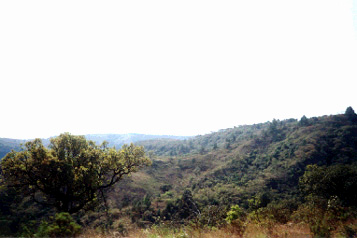
Chimanimani, Zimbabwe
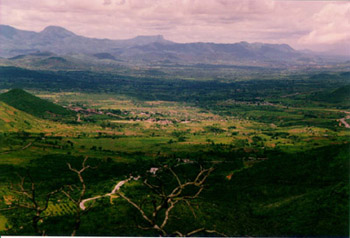
Mutare, Zimbabwe
| RAEL Home | Mission | About RAEL | Lab Members | Projects |
| |
| Publications | RAEL News | Public Outreach | Support RAEL | Contact Us |
| Robert Bailis
Ph.D. student |
Antonia Herzog, Ph.D. Postdoctoral Fellow | |
|
Energy and Resources Group University of California, Berkeley & | ||
|
Tinashe Nhete Rural Communities, Energy Projects Engineer | ||
|
Intermediate Technology Development Group (ITDG) - Southern Africa Harare, ZIMBABWE | ||
Project Background and Goals: Energy Needs and the Waste Resource Opportunity
The purpose of this project is to evaluate the implementation of several methods of sustainable power generation using wood waste produced by sawmills operating in the Manicaland region of Zimbabwe, close to the border of Mozambique. Currently, over 70,000 tons of this biomass waste is produced annually with long-term projections estimate that the waste produced will more than double by 2015. At the largest mills the amount of biomass waste generated on-site could alone yield as much as 4 MW of usable power. While at the largest mills a small fraction (~10%) of the wood waste generated is currently consumed in process steam boilers for lumber drying kilns, the vast majority is burned in the open air or dumped. Thus, this project has the strong potential to provide sustainable power and address a major environmental problem and inefficiency in plantation/sawmill production.
 Chimanimani, Zimbabwe |  Mutare, Zimbabwe |
The timber industry in Zimbabwe is almost entirely based on plantation timber, whose production is dominated by three large organizations producing about 87% of the national output. Plantation forests occupy about 0.02% of the total land area of Zimbabwe, comprising 81,000 ha of pine, 24,000 ha of eucalyptus and 13,000 ha of wattle, the majority of which are in the Eastern Highlands. The timber industry is the largest industry in the Manicaland province and employs more than 14,000 people directly. Sawmilling is the largest sector of the industry and is currently experiencing a boom, while the pulp, paper and board industries have generally not been able to keep pace with the growth in sawmill activities. Consequently, the demand for chips is less than the amount of chips and other wastes produced. This has given rise to open-air incineration and dumping in municipal landfills, contributing to local air pollution and global carbon emissions. When permission for dumping in municipal landfills is not granted, communal lands have been illegally used. While some sawmills have been designed to use a portion of the waste in their boilers to produce steam for drying kilns waste disposal remains one of the biggest challenges facing the industry and local municipalities.
In addition to waste disposal, other problems facing the timber industry and local communities include the dramatic increase in electricity tariff rates over the last year, as well as the growing unreliability of the electricity supply with unscheduled power outages adversly affecting the industry's profitability. Thus, utilizing the wood wastes for direct electricity generation either at the sawmill or at a more centrally located independent biomass power plant has become an attractive option. We are investigating the advantages of centralized biomass energy conversion supported by the sawmill industry inputs of wood waste fuel and the resulting distribution of power via power sales to the Zimbabwe Electrical Supply Authority (ZESA), the national utility. In addition, we are also investigating the sustainabilty of smaller scale community based power generation -- providing electricity to rural growth centers (e.g., small commercial enterprises, schools, clinics) or household electrification through mini-grids. In addition, we will consider the ecomomic feasibility of converting the wood waste to solid and/or liquid fuels.
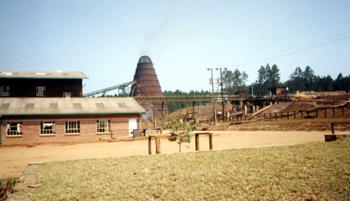 Forestry Commission (FC), Chimanimani Sawmill - wood waste beehive incinerator in the background |
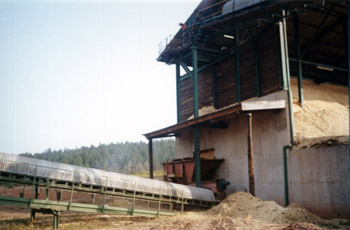 FC, Chimanimani Sawmill - sawdust being conveyed to boiler to generate steam for drying kilns |
To date there has been considerable interest in biomass to energy conversion projects in Zimbabwe by several groups, particularly from wood waste. Yet, although promising plans have been drafted they have so far stopped short of actual implementation. This is at least partially due to a lack of capital, lack of technical training, lack of detailed resource data, and a lack of staff or community involvement to help provide low-cost management of the biomass fuel.
Project Team
This is a collaborative community-industry partnership that will involve NGOs active in biomass energy and sustainable development and the national government through the development of a system for power sales to the regional electricity grid. Several sawmills in the region will also be involved in project developement and design. The main team directing the Zimbabwe biomass energy project are Professor Daniel M. Kammen, Director of RAEL at UC, Berkeley and Mr. Tinashe Nhete, Energy Specialist at ITDG - Southern Africa, an international NGO. Both have worked extensively on the economics and politics of local energy programs, and on the economic and policy issues surrounding aid-based and market-initiated development efforts.
Dr. Kammen has worked on community participation and forestry issues in Latin America, East Africa, and Indonesia, while ITDG - Southern Africa has extensive experiences with biomass energy and, critically, with the evaluation and implementation of socially appropriate household and community collective energy plans for local and regional development. Other collaborating groups that have explored the technical and economic issues surrounding small-scale biomass energy combustion, include the National Renewable Energy Laboratory (NREL), African Energy Policy Research Network (AFREPREN), the Biomass Users Network (BUN) - Zimbabwe, and the Energy and Development Research Center (EDRC) at the University of Cape Town, South Africa. Economic and power generation experts at Shell International, and energy and development specialists in the Africa Division of the World Bank have also agreed to take an active role in planning and evaluating the project's technical and economic plans and forecasts. In addition, experts from the Zimbabwe Electrical Supply Authority (ZESA) will be involved in the design and implementation of power purchase agreements from the project.
The project team will work to develop an implementation plan, and provide feedback to all groups potentially interested in employing biomass-waste energy projects. With our technical, economic, and sociological research results as a basis our aim is to provide a center for information exchange to support the fledgling biomass energy industry. As a university-NGO-private sector collaboration this project has the unique potential to provide a resource that has often been cited as missing and slowing progress in the past.
Local Project Objectives
The project's objectives are multifold. We plan to initially examine the technical and economic feasibility, the effect on forest-management practices, and the social implications of available biomass energy generation alternatives for this region. This will be carried out while working closely with the local sawmills, community groups, municipalities, NGOs, and the national utility to evaluate the potential for implementation of various bioenergy technologies. We also intend to build the local capacity to implement, maintain and manage biomass conversion systems. Finally, we intend to develop a set of technical and economic assessments, and best practice training materials for the implementation of similar projects in other developing countries.
We are investigating the use of wood waste in the direct production of power. This can be accomplished by utilizing several different technologies capable of electric power production in the 0.5-10 MW range. The idea is for the sawmills and/or local communities to use the electric power produced, with excess being sold to the local municipality and/or national utility company. Currently the plants in question receive their power from ZESA, the national utility company, while local communities surrounding the sawmills have little or no access to the national power grid. Other schemes could include the conversion of the wood waste to more useful forms of combustible energy to be used by the sawmills in their production process with excesses sold locally as a secondary source of income for the mills. Examples being considered are pelletization or briquetting (carbonized or untreated), distillation into liquid fuels, or gasification.
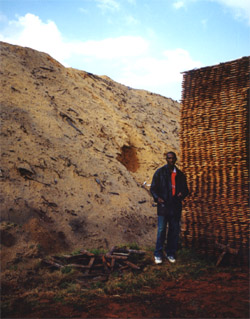 Tinashe Nhete in front of a pile of sawdust waste at Troutbeck sawmill, located in Nyanga | 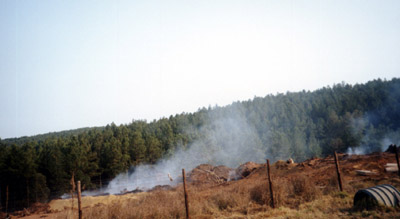 FC, Chimanimani - wood waste being burnt in back of the sawmill |
The generation of power from the wood waste of Zimbabwe's sawmills raises several questions. One issue worth examining is the appropriate scale for power generation. The optimal level is not necessarily the maximum allowed given the feedstock available. The old paradigm of power generation, that plant size be maximized to take advantage of economies of scale, has to be balanced with environmental factors, questions of sustainability, and in the case of rural power consumers, limitations in, or complete absence of, a power transmission infrastructure. ITDG has had extensive experience exploring these issues for a range of fossil fuel and renewable energy technologies, and the project will begin with a detailed impacts assessment for each of the stakeholders involved.
Equity and local access are also both issues of concern to the communities living in proximity to the sawmills. We shall examine the various levels of energy use relevant to these communities to determine how the excess wood waste could help them meet their energy requirements. Of particular interest on the community level are methods of cooking in households and small institutions (the area which consumes the most energy in rural areas), as well as any increases in local economic output resulting from the availability of affordable electric power. Intermediate scale power generation may facilitate private commercial enterprises on many scales: household, village collectives, and innovative partnerships with the regional sawmills.
Project Outline
The project is estimated to run 24 months. It will begin with fuel, forest, and technology assessments and an analysis of economic viability at the household, community, and corporate sawmill levels of the various technical options. This phase will lead to a set of economic feasibility plan for local energy management, and for power provision to the regional utility grid. The next phase of the project will then be to follow-up in future years, with stakeholder involvement and investment, in a full-scale and adpative implementation of the most promising energy and community management systems with an on-going assessment of their social and long-term community and ecological impacts. This will directly lead to the future drafting of documents exploring the details of the lessons learned and the viability of regional or global project replication. Central to the entire project will be the examination of biomass energy in a broader development and conservation plan for the region.
Summary
An exciting aspect of this project is the degree to which the Eastern Highlands of Zimbabwe presents a unique technical, political, economic, and environmental region for the study of sustainable biomass energy schemes. The Eastern Highlands and western Mozambique encompass a steep altitude and environmental gradient where a diverse set of tree species thrive, as well as a wide range of non-timber products (mushrooms, rattans, tubers, maize, ranch and free-range cattle and goats, and so forth). These crops can all be raised and evaluated in conjunction with wood to expand the economic and sustainability value of the biomass energy scheme. This diversity is particularly important to household and community groups that have limited access to land holdings, and require payback times shorter than large industries such as the sawmills.
The diversity of economic schemes in the region also means that alternate forms of land and rent can be tested. For example, land lease, and collective resource management are all possible in the region. It is likely that the limited resources of small-holders will require that this biomass scheme provide training and access to discussions and information on collective resource control and profit-sharing to make this scheme truly beneficial to the community groups. Finally, the contacts of Dr. Kammen, ITDG, and the sawmill industry will provide direct and active routes to test the viability of implementing the programs developed in this project in other developing nations.
RAEL is committed to conserving natural resources through sustainable energy and land use by undertakings applied research projects that develop and implement innovative technical and social solutions to global energy use, with a focus on the developing countries. This bioenergy project fits well with these goals and has the strong potential to provide sustainable power and improve the environment in eastern Zimbabwe. In addition, it is strongly based upon the belief that working with the local community and industry along with NGOs and governmental groups is critical if positive change in energy use is to occur and in such a manner that neither harms the local population or their environment.
This project is funded by the:
Pasztor, J and Kristoferson, L. (1990), "Bioenergy and the Environment - the Challenge," in Pasztor and Kristoferson (eds), Bionergy and the Environment, UNEP.
Back to the Top
Last updated 10/13/2000